You’ve researched your seeds, tested your soil, planted, watered, and fussed. Your tomatoes are top-notch, and your peppers are popping — but what is this? A hornworm? An infestation of aphids? You’re not going to just hand over your bounty to a bunch of ravenous bugs. You put too much into your garden. It is important to get this pest problem under control. Do you know what to reach for? Do you know how to the do organic pest control on your plants? It might just be the most valuable tool in your shed.
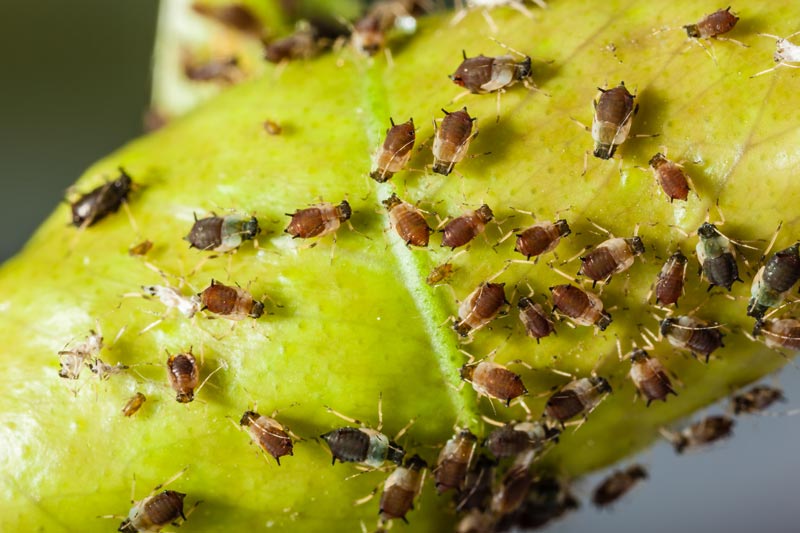
Pesticides: What Are They?
Pesticides are chemical mixtures used to kill or repel crop damaging insects and bugs. A pesticide can be either synthetic or organic, or a combination of the two.
Some pesticides kill a wide range of insects while other pesticides target specific types of pests. A number of pesticides are ‘contact’ toxins that can be sprayed directly on pests and their homes.
Others are ‘systemic’, which means that they are absorbed by the plant and then transferred to the insect when the insect feeds on the plant. Some pests that may be present include spider mites, aphids, fungus gnats, squash bugs, and broad mites.
Most pesticides work by acting on the insect’s nervous system or by weakening the chitin that makes up its exoskeleton. However, using pesticides in gardens is a double-edged hoe. What is toxic for insects is often toxic to other living things as well, including us.
We want to control pest problems without compromising health. We also want to avoid killing any beneficial insects. It is essential to know what you put into your garden when growing fruits or vegetables.
Natural and Organic Pest Control
Rosemary, clove, garlic, vinegar, eucalyptus, and other common plants have been touted for their ability to repel pests naturally. Although a great natural choice, these pest control solutions have limited results and are not practical for your garden.
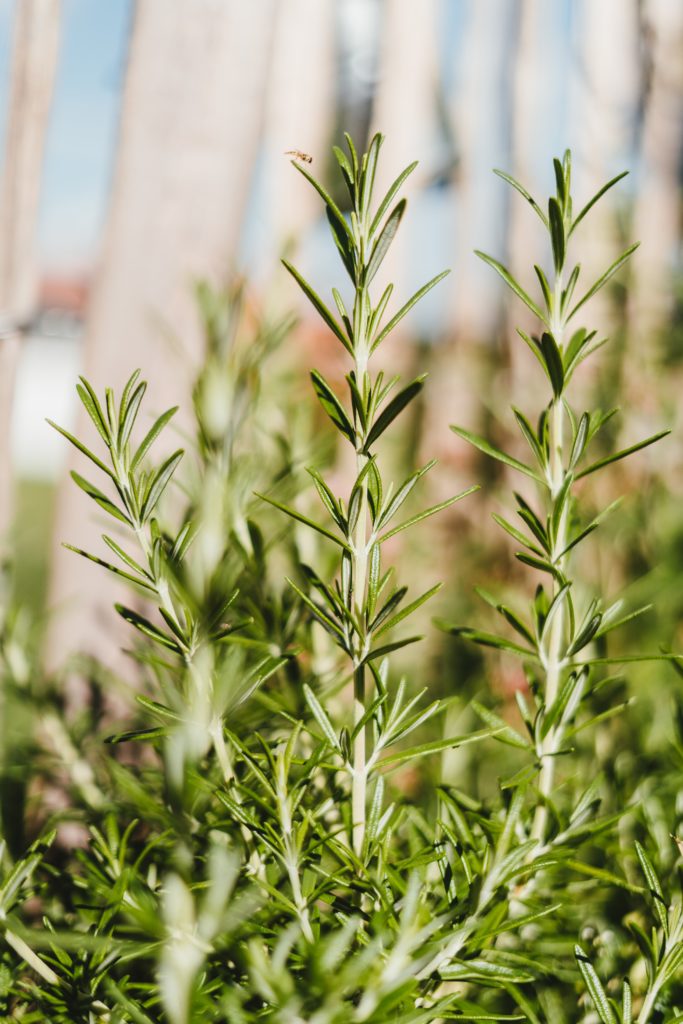
Repellents only keep insects at bay for a short time, not kill them. Knockdown pesticides are used when a pest is already present and you need to save your plants. A more effective method is needed if you are serious about your vegetable garden.
Row covers are another option to help protect plants from pests. Row covers are light and breathable. They go over the plants in your garden and help to protect them from temperature changes, wind, and pests.
Row covers are a great option to get ahead of the potential pest problems you may encounter. There are a variety of row covers you can purchase to fit your garden’s needs.
When researching the right pesticides for your garden, please remember that natural and organic do not necessarily mean safe.
In some cases, even approved pesticides and organic pest control methods can be harmful in the long run. The pesticide Rotenone, for instance, was reclassified. The EPA determined that Rotenone was reaching levels in the water that was toxic to humans.
What is the Most Effective Organic Pest Control Product?
Are chemical pest control methods not for you? Thankfully there are some natural and organic sources of pesticides that aren’t hard on the environment.
A handful of candidates stand out. We can break down these options into two categories: repellants and knockdowns. Say goodbye to toxic pesticides! Here is the short list of organic pest control solutions.
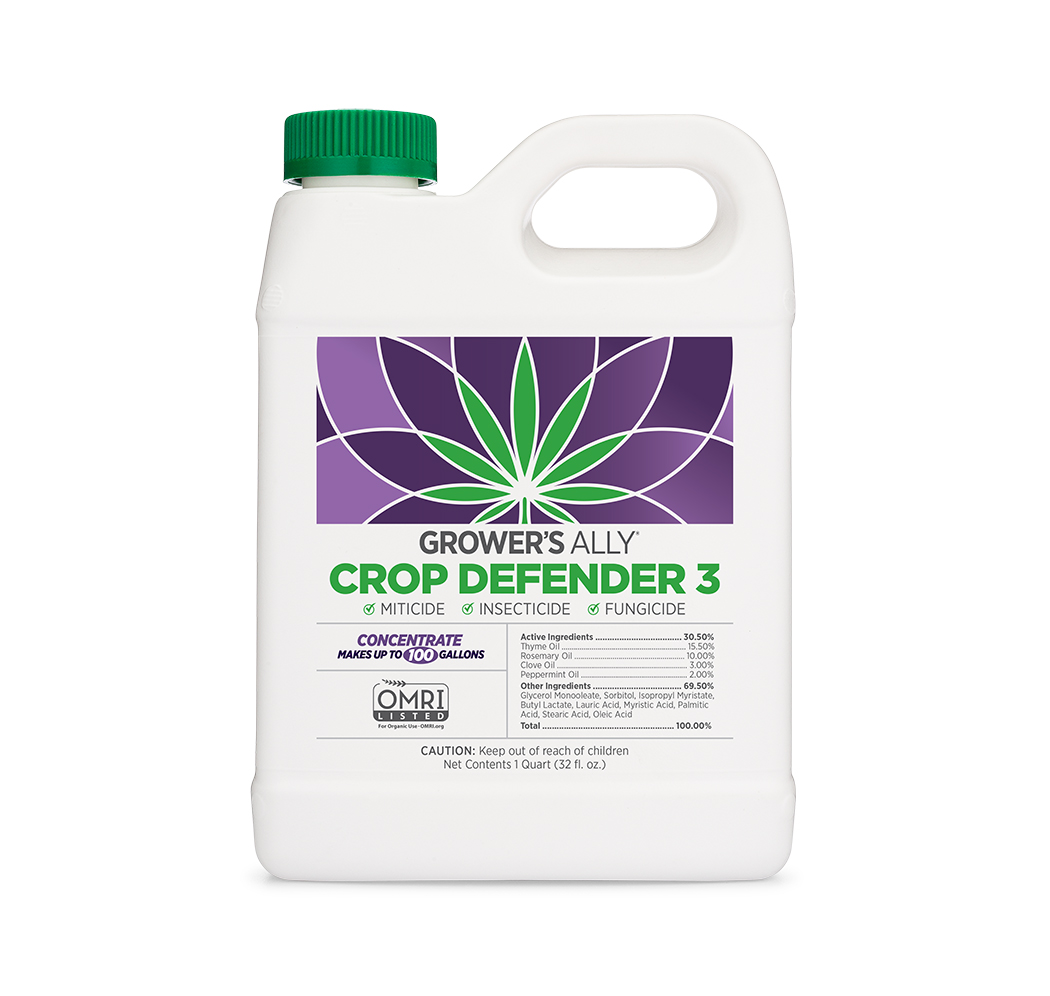
Grower’s Ally Crop Defender 3
This is a top of the line organic product. It is completely safe to use on crops of all types, and it is much more effective compared to almost any other organic pest control product.
It has a effective rate of nearly 100% on most bugs and eggs.
Most importantly, it will not clog the stomata or leave residue on the plant like other most other knockdown products.
The volatile organic compounds (VOCs) evaporate within hours of application and your vegetables can be harvested the same day of application.
Grower’s Ally Crop Defender 3
Grower’s Ally Crop Defender 3 is one of the best organic knockdown pesticides to control pest infestation. They grow their own inputs so they are in control of both their quality and supply chain.
Not only does this pesticide smell nice when compared to other pesticides, but it is completely safe to use. It also will not alter or degrade trichomes or trichome production. There is no PPE required and it is so safe that vegetables can be harvested the same day of application.
Grower’s Ally Crop Defender 3 beats out its competitors because it does not leave any residue on the plant. Most knockdown products consist of salts from fatty acids and thick vegetable or plant oils. These can clog the stomata.
If the stomata are not clogged and light intensity is at its peak, the plant can photosynthesize effectively. Other products tend to leave residue on the plant which means that the gas exchange that occurs in stomata is halted.
If the gas exchange is compromised, photosynthesis cannot occur. This can stunt the growth of your plants.
Neem Oil
This organic pest control method comes from the seeds of the neem tree. It has half the toxicity of the next safest natural pesticide and is 10 times safer than pyrethrum.

This natural pest control method works to coat the insect, which disrupts its ability to exchange gasses (breathe). It is an antifungal, especially against those that attack roses, fruit trees, and vegetables.
It also interferes with the maturation of juveniles. Some concentrated neem products like Azapro extract the active ingredient, azadirachtin, to be more effective. Azadirachtin is a highly effective insect anti-feeding agent that attacks insects at every stage of their life cycle.
Azapro and azadirachtin based products are used to control more than 300 different insect species.
Keep reading, and we’ll give you some instructions on how to mix and apply Azapro as part of your organic program for controlling pests.
Bacillus thuringiensis (B.t.)
Over 80 strains of this bacterium supply the essential ingredient in this class of pesticide. The insects ingest the bacteria, which prevents digestion. It essentially starves the pests. The right strain will specifically target the specific pest you’ve identified.
However, locating and identifying harmful insects takes some experience. If you are uncertain which kind of insect is munching on your precious cukes, you may be better off with a wide-spectrum pesticide.
Safer Brand Caterpillar Killer is an organic pesticide option that contains Bt It is primarily used as a knockdown pesticide to rid your plants of caterpillars and leaf-eating worms. Although a popular choice, it is specific to caterpillars and worms.
Insecticidal Soap
“Insecticidal soap is made from the salts of fatty acids.” It attacks the cuticle (outer layer) of insects. Bt is proven highly effective against a large number of soft-bodied pests. Keep in mind that those with exoskeletons can be resistant.
Safer Brand also makes an insecticidal soap. It is a knockdown category of pesticide that claims to rid your plants of any toxic pest. Grower’s Ally Crop Defender 3 still is the winner of knockdown pesticides.
Horticultural Oil
Horticultural oil has many different names, but they are all made of petroleum (paraffin or mineral oil.) It works in a similar manner to other organic options.
It may be more viscous, and impurities in petroleum cause damage to tender or drought-stressed plants. You will also get less consistent results than you would with a single-source oil like neem.
Dr. Earth Organic Final Stop Vegetable Garden Insect Killer is an essential oil blend that can be used as a knockdown insecticide. It can be used to kill a variety of toxic pests.
FoxFarm Force of Nature has three varieties of pesticides. The insect repellant, a miticide, and a fungicide. Miticide and fungicide are knockdown pesticides. These are oil-based pesticides.
These oil blend pesticides have the potential to leave residue on the plant and this can be an issue. Residue can clog stomata and stunt the growth of your vegetables. Grower’s Ally Crop Defender 3 will not clog your stomata or leave residue on your leaves!
Diatomaceous Earth
Diatomaceous earth is a mixture of silica and the shells of microscopic creatures called diatoms. This food-grade pesticide tries to abrade its targets into non-existence. The sharp crystalline structures in food-grade diatomaceous earth scratch up insects’ outer layer, causing them to dehydrate.
Safer Brand makes a Diatomaceous Earth insecticide. It is a knockdown pesticide that kills insects within 48 hours of application.
This type of pesticide is especially effective against slugs. Unfortunately, diatomaceous earth does not discriminate and will kill beneficial insects along with the pests. It is also a lung irritant.
Pyrethrum
Derived from chrysanthemums, pyrethrum-based pesticides are a quick and efficient killer. Unfortunately, it affects a wide spectrum of arthropods, including honeybees and other arthropods that are beneficial to vegetable plants.
The Collateral Toxicity of Pesticides
The history of farming is partly the history of learning how to poison pests without poisoning the crops and environment. It is also about figuring out how to not kill beneficial insects.
There is an unfortunate inverse relationship between a pesticide’s effectiveness and its toxicity to the environment. Pesticides have made it possible to feed millions but they have also damaged swaths of our ecosystem.
Our scientists are doing their best to make pesticides safer. Indeed, modern pesticides are safer and less toxic than ever. Although, when products are categorized by levels of toxicity (tables 7, 8), it makes sense to remain wary.
We can forgive farmers for being wary of synthetic pesticides since it took decades to realize the consequences of using chemicals. How do we protect our vegetables without unwittingly damaging our environment?
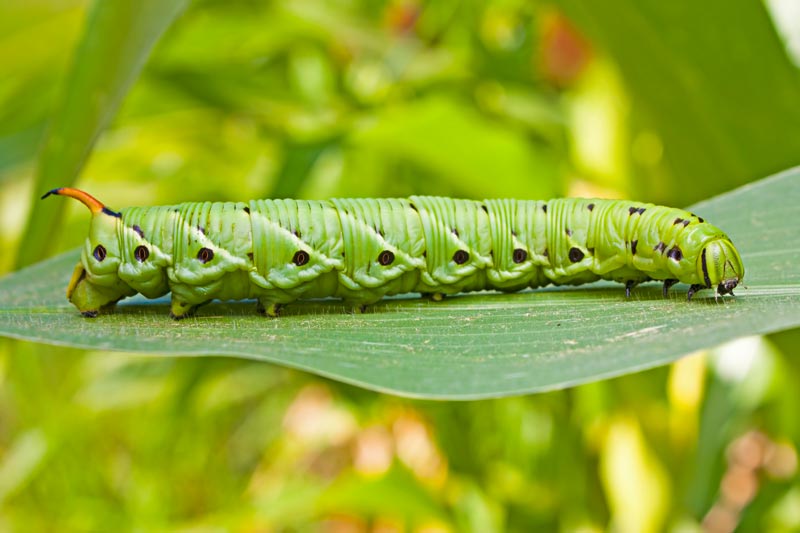
A Brief History of Pesticides
The history of humans’ efforts to exterminate bothersome bugs goes back millennia. The earliest efforts stemmed from the use of common plants and minerals. The use of sulfur as a pesticide was common in ancient Greece.
Chrysanthemums (pyrethrum) were used 2000 years ago. Farmers adopted the use of neem oil, which began used as an ingredient in traditional Indian medicine.
They used the oil to fight insects in Asia over the last millennia. American farmers have used tobacco (nicotine) to eliminate pests since at least the 17th Century.
Dangerous DDT
In the 1930s, Modern farmers adopted the use of DDT as a chemical pesticide. At the onset of WWII, the U.S. military used pesticides to protect troops from malaria and other insect-borne tropical diseases. Farmers adopted it as an easy and effective way to eliminate insect populations.
Originally regarded as harmless to mammals, DDT became widely available in post-war America. As the years passed, the dangers of the chemical became clear. Beginning with insects sprayed with DDT, the presence of the chemical became magnified as it moved up the food chain.
Apex predators began accumulating toxic levels. Fortunately, a ban on its use in 1972 has allowed species to begin recovering.
Beneficial B.t.
Another big discovery in pesticides happened in the same era as DDT. In the 1920s a bacterium called Bacillus thuringiensis (B.t.) killed insects when sprayed on crops.
In 1976, Bt’s mechanism for killing pests was finally understood. Its use (in the form of a protein extract) became widespread. Stung by the DDT debacle, various agencies scrutinized Bt. By 1991, the scientific consensus was that Bt is harmless to mammals.
Pesticides 1970s to Present
The 1960’s and 1970’s saw the rise of ecology and environmental awareness. Age-old solutions, such as neem oil and pyrethrum returned to prominence as effective pest killers.
As recently as the 1990’s, another pesticide came to market with much promise. Neonicotinoids were found unacceptably toxic. Agriculture’s new darlings, neonicotinoids, have been applied to over 140 crops for three decades.
Neonicotinoids are now recognized as lethal to honey bees and ladybugs. Furthermore, it remains in the soil for a long time. Neonicotinoids remain a common ingredient in pesticides, but their use is currently contested in court.
Today, the U.S. uses about 100,000 tons of pesticides a year. Perhaps surprisingly, more is used by home and garden enthusiasts than by commercial agriculture (EPA). What you choose to spray in your vegetable garden will affect not only your crop but you and your environment as well.
Easy Neem Oil Spray Recipe
If you want to study the effects of neem oil in your vegetable garden before buying a commercial mix, you can make a small batch at home. Here’s how to do it:
- Gather water, cold-pressed neem oil, and dish soap. You will also need a spray bottle.
- Add one or two drops of dish soap to a manageable amount of water (around 1 liter or 1 quart). As we all know, oil and water don’t mix. So we use a little soap to help the oil and the water base cling together.
- Add neem oil. Begin with a small amount — 0.5 to 2% of the water volume.
How To Apply Neem Oil for Organic Pest Control
Now that you have your spray bottle full, it’s time to apply it to your precious vegetables. It is a good idea to choose a ‘test’ plant and wait a day before spraying more broadly.
Although this pesticide is non-toxic, you may experience skin irritation. So, don your gloves, mask (not difficult to find these days!), and eye protectant.
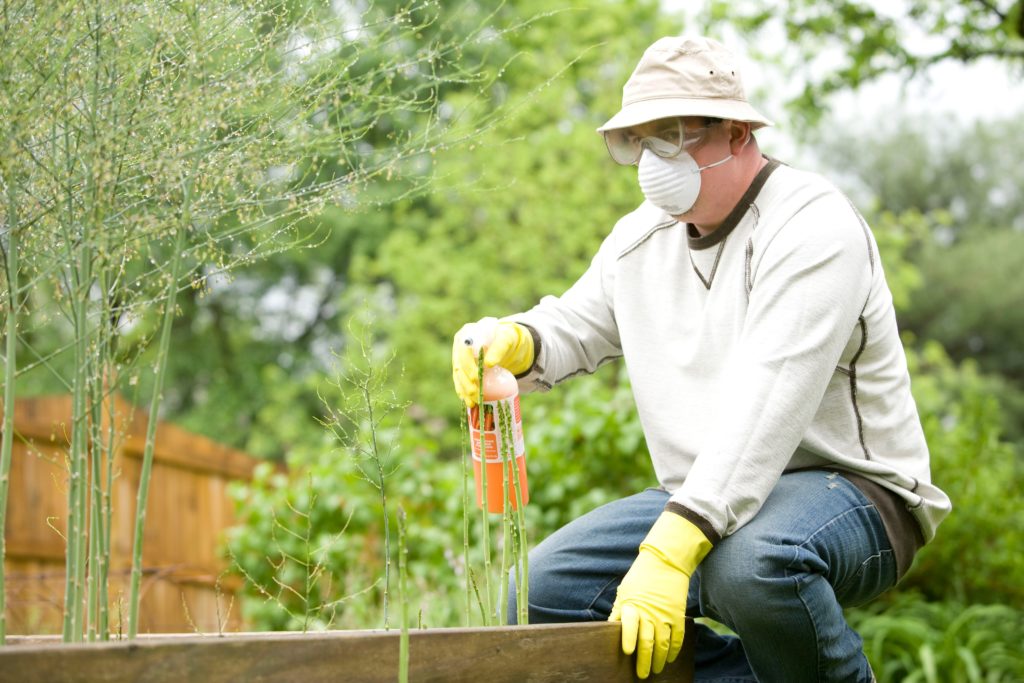
- Give the leaves a thorough spray. Be sure to spray the bottoms of the leaves as well as the tops! (Remember, insects like to hide on the undersides of foliage.)
- If you have blossoms or vegetables, do not spray them unless you are certain they are the target of your pest.
- Don’t be stingy when you spray! You want an even coating of oil everywhere an insect wants to chew. Simply spattering the leaves like a passing rain does little to inhibit pests.
- Repeat the process every 2-3 weeks.
Another advantage of this method is that it disrupts the growing cycle of newly hatched pests. This helps because fewer will reach egg-laying maturity.
Stay consistent and you should see smaller numbers in successive generations. With a bit of luck, you may not have to spray at all when your harvest comes.
The Results: How do You Control Pests Organically?
We’ve needed pesticides since we began tending crops. There have been a few hard lessons along the way, and our environment has paid the price. Reliable organic pesticides come from a little bacterium we like to call Bt, and from the seed of a neem tree.
There is no perfect pesticide and that is okay! Different pests require different solutions. Consider your choices, and weigh their pros and cons. Bt-based pesticides are your best option if you are a skilled entomologist, or are working on a large scale with a single crop.
Neem oil is also a great choice because it is wide-spectrum.
The best option is Grower’s Ally Crop Defender 3, hands down. It helps get rid of all pests while still allowing the plant to breathe. The stomata remain unclogged and your plant growth will flourish.
This season, when it comes time to protect your vegetables from insects, remember how effective and non-toxic these natural ingredients are.
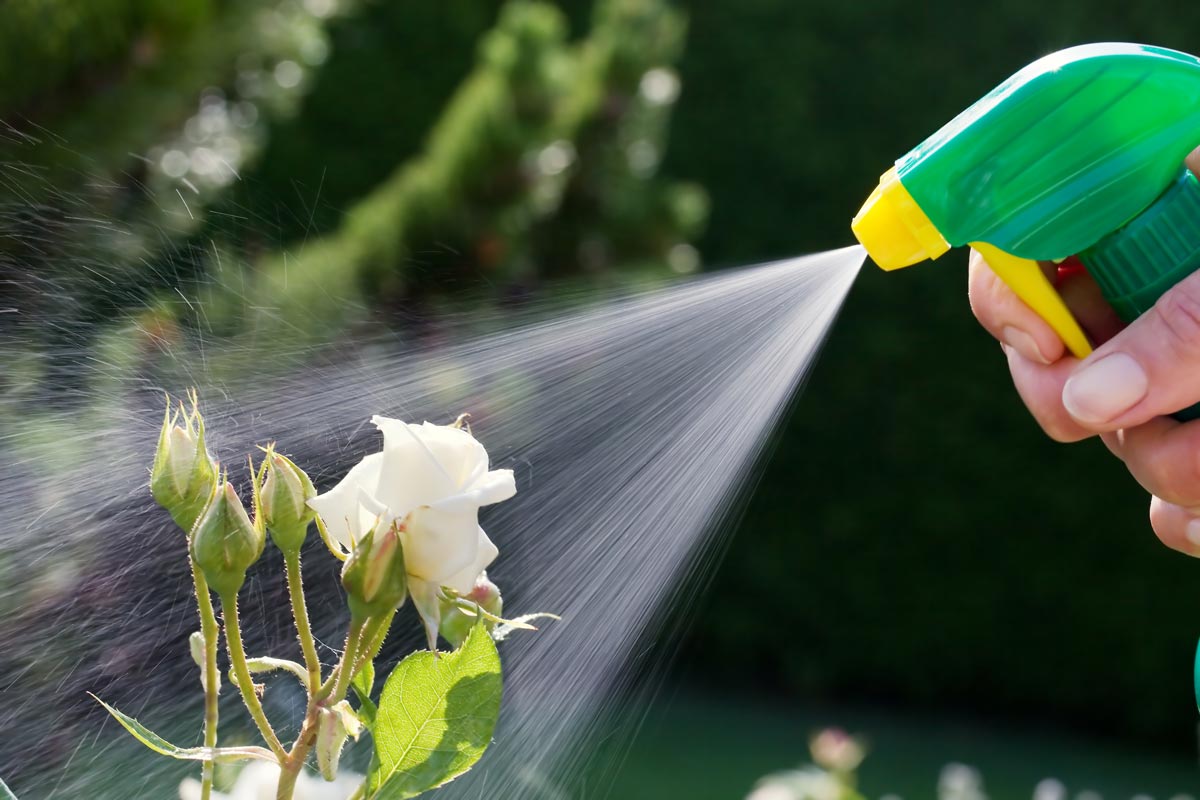

We raise honey bees that live close to the gardens so killing them and butterflies at all stages would be bad. Is there product like that, that is safe.
Hi Debbie,
Thank you for your question. YES! Grower’s Ally Crop Defender 3 is an excellent product that will NOT harm pollinators. It is also OMRI listed and 25(b) FIFRA exempt. Totally safe. https://www.globalgarden.co/products/sanitation/growers-ally-crop-defender-3/